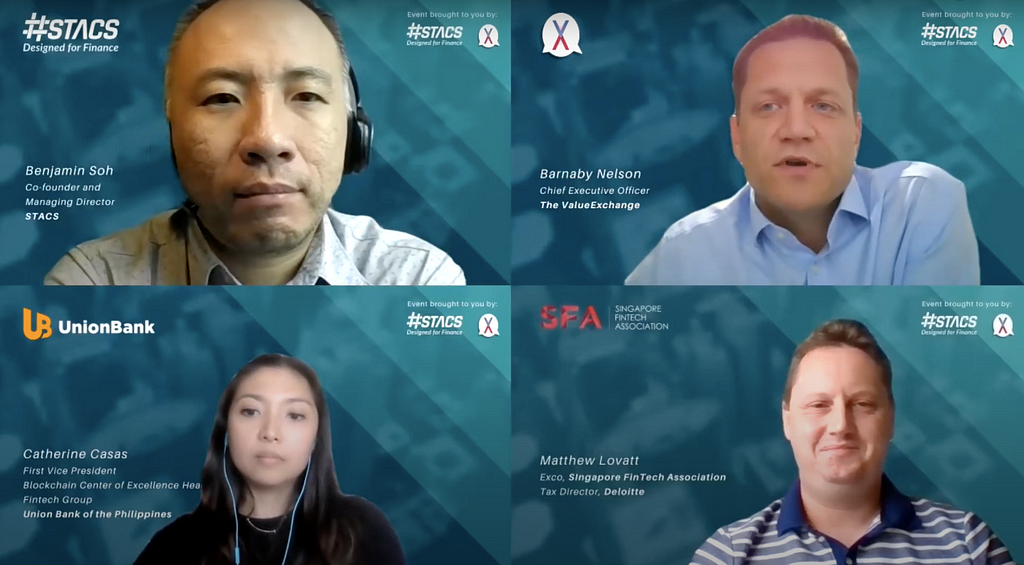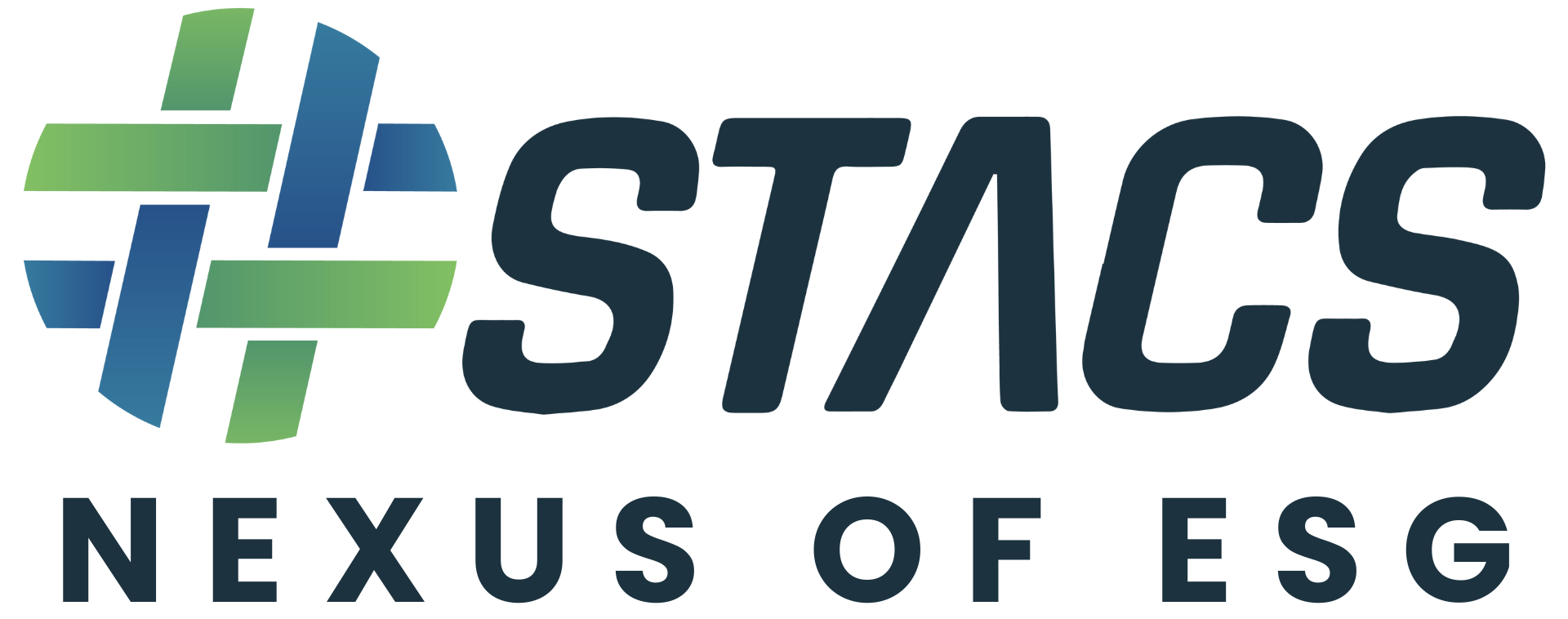The next five years of Enterprise Blockchain: DLT in Financial Markets — Industry Panel by STACS and The ValueExchange, with Singapore FinTech Association (SFA) and Union Bank of the Philippines

Enterprise blockchain is five years old. What have we learned? Achieved? And what can we expect in the next five years and beyond?
In celebration of the upcoming sixth anniversary of enterprise blockchain, STACS hosted a global industry panel with The ValueExchange on 7 July, with esteemed speakers from the Singapore FinTech Association (‘SFA’), and the Union Bank of the Philippines (‘Union Bank’).
Diving into real-world deployments and collaborations by global financial institutions, this industry panel is not to be missed for anyone interested in building their own business case for DLT-based transformation or who wants to find out how it can unlock value for their institution.
Watch the full panel here —
Bringing a variety of perspectives from financial inclusion, to tax, regulatory and ecosystem support, to global industry adoption, and to, of course, fintech, speakers included Barnaby Nelson, CEO of The ValueExchange (who was also the moderator of the session); Matthew Lovatt, Exco at SFA and Tax Director at Deloitte; Catherine Casas, First Vice President of the Blockchain Center of Excellence and Head of FinTech Group at Union Bank; and our own Benjamin Soh, Co-Founder and Managing Director at STACS.
Read on for some of the key insights shared by Ben, who zoomed into the perspective of STACS as a FinTech during the discussion, and be sure to watch the full session over on YouTube to get a full range of perspectives from the distinguished panelists.

The financial industry agreed on the green value of DLT
Where things stand today, we are seeing various opportunities in DLT in terms of creating new efficiencies for workflow automation between different companies and parties, such that we are able to apply this innovative technology in allowing financial institutions to re-allocate previously locked up capital.
This re-allocation could be towards new opportunities in capital distribution, liquidity, and of course ESG investing where we see client-driven demand.
A very startling fact, which I have touched on in the past, is that there is still a US$2.5 trillion funding gap based on the United Nations Sustainable Development Goals, even though globally we are increasingly experiencing the real effects of climate change.
Although the sustainable debt market has hit about a trillion dollars in size every year, only 0.3 per cent of all bonds issued globally last year were what we might consider “green”, and this scenario persists.
It is becoming clear that we must use technology like enterprise blockchain to automate workflows and bring about efficiencies in the capital markets to unlock some of the US$800 billion that is still locked up every single day in clearing houses globally.
Freeing up some of this capital and resources, not to mention the associated man-hours, and channelling it into more productive and valuable use cases (including ESG) is the right way forward for financial markets in the next five years.
These are all being largely driven by investor demand: it is the investors, financial institutions, and asset managers today that are starting to see the pivotal need for a common platform that transcends projects and jurisdictions, which is ultimately able to provide reliable data to combat greenwashing.
Based on one survey we took part in last year, 79 per cent of firms in the financial industry have already dedicated resources to DLT projects, which suggests industry stakeholders are seeing the real measurable value in DLT that goes beyond just hype.
As an industry, we are now starting to apply DLT technology to real commercial use cases that will unlock tremendous value for the entire financial ecosystem, not to mention the green efforts of the planet.
Multiple participants on a single platform
This leads us nicely to our Bonds in a Box solution, a collaboration we jointly led with Deutsche Bank earlier this year towards tokenising bonds by putting them on a DLT platform. (We call it “Bonds in a Box” because the solution condenses key market structure in a single platform, and manages the entire bond lifecycle. We added interoperability to the platform to facilitate adoption and effective digital custody and overlaid the arrangement with a legal and regulatory review for practical workability. This “box” was run against real-world use cases.)
To make this work, we required the collaboration of industry participants and were fortunate to be able to work with Catherine from Union Bank as well as a few other participants including UBS, Deutsche Bank, and Bursa Malaysia.
Since then, we have seen increasing media reporting from the likes of the Financial Times and others discussing the various benefits of having the bonds on the blockchain.
Of course, it would be naive of me not to admit that certain challenges remain with integration — there are costs on this front for the banks, especially to be able to interoperate with other banks (one of the key pain points highlighted in the FT article).
This is precisely one of the challenges that we at STACS are trying to overcome: the need to have multiple participants operating on the same platform and project.
Nearly all of the DLT projects that came before us were largely operating in “islands” or silos, where the value of the technology could not be maximised (due to individual participants operating alone).
I am still proud of the whole team at STACS for the proposal we submitted to the Monetary Authority of Singapore (MAS), which underwent an evaluation process and was ultimately accepted under the Financial Sector Technology and Innovation (FSTI) scheme administered by the MAS.
To me, this was a real validation by a national regulator and central bank that there is value in what we are going to provide for the industry, and we have since published a report co-written with Deutsche Bank and our industry collaborators, on our achievements in line with the scheme’s requirements (available in full on our website here).
In a nutshell, the real objective will be to enable multiple participants (i.e. banks) to operate together on a single platform, and it is with great satisfaction that I believe we have achieved that.
Whether it is with Union Bank, a commercial bank in the emerging market of the Philippines where there is a large number of retail customers; or with UBS, an investment bank with a global wealth management business that is also a large bond arranger; or with Deutsche Bank, a great global custodian service provider.
Alternatively, with Bursa Malaysia, a national stock exchange, we were able to capture the entire lifecycle of a bond on a single platform — in all these cases we have been able to demonstrate the practicality of our technology for the capital markets.
Don’t sacrifice liquidity for the sake of innovation
Proof of commercialisation projects have been major payoffs for us precisely because they allow us to establish the feasibility of our technology in real-world commercial use cases.
Having multiple banks involved and a technology platform that was interoperable through API’s with various systems (i.e. external payment systems or third-party platforms the banks may be using), we were able to establish that feasibility to run entire projects in live commercial settings from end to end.
It is certainly the case that many financial institutions that want to onboard DLT systems are requiring the technology providers to ensure interoperability with their existing infrastructure — we cannot just create another island or another market that is not accessible by traditional liquidity.
To re-emphasise: we do not want to sacrifice liquidity for the sake of innovation.
We have been able to quantify more than 60 per cent savings in the number of process steps required for bond issuance, even with a process where we were integrating with traditional infrastructure.
In other words, if one day, we as an industry are able to one day make this the default infrastructure then, of course, efficiencies will be higher than they are today, but this will be many years down the road, from where the industry currently stands.

Nexus to the financial industry and real-world projects
Following our Bonds in a Box concept, the question of green bonds was a natural next step: indeed, the timing was perfect because as of the end of last year there has been growing attention on ESG financing (the pandemic has also created a renewed focus on anything digital).
In Singapore especially, we are blessed to have the support of MAS, which recently announced that it would commit funding to support industry implementations of technologies enhancing ESG financing.
From the STACS perspective, it has been easy and organic to extend our functionality to support this ESG drive by the government; it is also something that resonates with us as a company and our desire to use technology to make societies better, and the planet more sustainable.
For instance, tracking and tracing of the entire distribution channel and supply chain of physical real-world projects, from manufacturing to destination, requires a distributed infrastructure to allow connectivity to various data sources (something we provide).
This could be IoT sources, data analytics or even satellites, which are continuously monitoring in real-time projects as they develop.
It is not only at the point of applying for a bond or loan where the “green” criteria matter: it is throughout the entire process and the project’s lifetime, such that investors can be certain their portfolio is truly green, and there is no greenwashing involved.
For the financing of a sustainable/green bond or loan, investors increasingly want to be able to see that the use of proceeds has translated to real KPIs and results in the ESG sense: this involves receiving real-time data and applying analytics, as well as securing third-party certification from agencies such as Deloitte.
Such a platform will become a trusted common layer able to provide green certifications as a service across multiple participants and corporations involved in the budding green market.
It is our hope at STACS that the platform we have live and are constantly reinforcing with our collaborations with leading FIs and tech firms, will become just such a platform-as-a-service solution for global green financing, where participants are able to easily quantify and show reliably their project’s “greenness”, and in turn secure better financing.
A final point here is that the amount of carbon emissions participants are able to offset could become carbon credits as long as it is being reported and calculated in an industry-standard way.
As you can see, there are a lot of different ways we see our technology helping on the ESG front, and we are excited to see ourselves as a nexus between the financial industry and real-world projects under a common digital platform.
We would like to thank The ValueExchange for co-hosting this successful event, and the distinguished speakers — Barnaby, Matthew, and Catherine, for sharing your valuable insights and expertise with us.
About STACS
STACS (Hashstacs Pte Ltd) is a Singapore FinTech development company with a Vision to provide Transformative Technology for the Financial Industry, with its complete infrastructure of live institutional green and ESG-enabling platforms that make global markets simpler. STACS is leading the way forward by digitalizing assets, processes, and documents using its patent-pending STACS Blockchain technology. Its clients and partners include global banks, national stock exchanges, and asset managers. STACS is The Asset Triple A Digital Awards 2021 FinTech Startup of the Year, an Award Winner of the Monetary Authority of Singapore (MAS) Global FinTech Innovation Challenge Awards 2020, and a two-times awardee of the Financial Sector Technology and Innovation (FSTI) Proof of Concept (POC) grant, under the Financial Sector Development Fund administered by MAS. STACS aims to empower financial institutions to unlock massive value and discover new opportunities through our technology.
For Enquiries
[email protected]
Website
www.stacs.io




